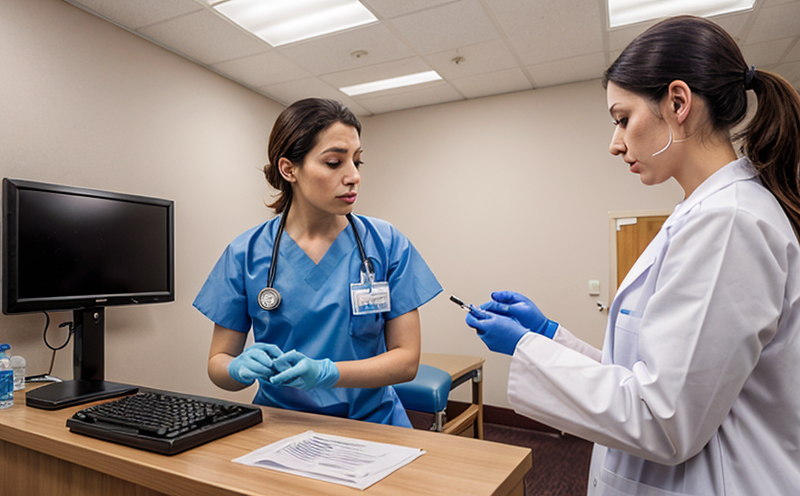Carbamate Pesticide Residue Testing in Vegetables
In the realm of clinical and healthcare testing, ensuring the safety and purity of food products is paramount. Among these tests, carbamate pesticide residue testing in vegetables stands as a critical component that guarantees consumers are protected from harmful chemical residues.
The primary focus here is on detecting carbamate pesticides, which are widely used in agriculture to protect crops against pests and diseases. However, excessive or improper use of these chemicals can lead to their presence at levels that exceed safe limits set by regulatory bodies like the FDA and the EU Commission. Therefore, it is essential for laboratories to perform accurate carbamate pesticide residue testing in vegetables.
The testing process involves several steps including sample collection, preparation, extraction, analysis using HPLC (High Performance Liquid Chromatography), and finally reporting the results. Each step requires precise execution to ensure reliable outcomes. Proper sample handling ensures that no contamination occurs during the process. Extraction methods such as QuEChERS (Quick, Easy, Cheap, Effective, Rugged, and Safe) are commonly used for effective extraction of pesticides from vegetables.
The analytical tools employed must be capable of detecting extremely low concentrations of carbamate residues to comply with strict regulatory standards. This requires sophisticated instrumentation like HPLC coupled with UV detection or Mass Spectrometry (MS). Such equipment is not only highly sensitive but also selective, ensuring that only the targeted compounds are detected.
The importance of this testing cannot be overstated. Not only does it safeguard public health by preventing ingestion of harmful residues, but it also supports regulatory compliance and helps in maintaining consumer trust. By providing accurate and reliable results, laboratories play a crucial role in upholding food safety standards and contributing to the overall well-being of society.
Regulatory bodies like the FDA, the EU Commission, and others set stringent limits for carbamate residues in food products. Adherence to these standards is mandatory, and any deviation could lead to product recalls or legal action.
Accurate testing requires not only state-of-the-art equipment but also skilled personnel who understand the intricacies of each step involved. The process starts with selecting appropriate vegetables based on their susceptibility to carbamate residues. Samples are then carefully prepared according to established protocols, ensuring that they represent a true reflection of the product.
The extraction method used is critical in determining the efficiency and accuracy of the test. QuEChERS is favored for its simplicity and effectiveness in extracting pesticides from various types of vegetables. Once extracted, the samples undergo analysis using HPLC or MS to identify and quantify carbamate residues.
Scope and Methodology
| Aspect | Description |
|---|---|
| Samples Collected | Leafy greens, root vegetables, and other types of vegetables that are commonly treated with carbamate pesticides. |
| Extraction Method | QuEChERS method for efficient extraction of residues from the vegetable samples. |
| Analytical Instrumentation | HPLC coupled with UV detection or Mass Spectrometry (MS) to ensure accurate quantification of carbamate residues. |
| Acceptance Criteria | Results must comply with the regulatory limits set by bodies such as FDA and EU Commission. |
| Data Reporting | Comprehensive reports detailing test conditions, results, and compliance status are provided to clients. |
| Quality Control | Dedicated QC protocols ensure that every test adheres to the highest standards of accuracy and reliability. |
The testing process begins with collecting representative samples from different batches or lots. These samples are then prepared according to standard procedures, ensuring they are free from any contamination before proceeding to the extraction step. Extraction using QuEChERS ensures that all residues are effectively removed and concentrated for further analysis.
Analyzing these extracts requires precision and care. HPLC with UV detection or MS is employed depending on the specific requirements of the test. This equipment allows for precise measurement down to parts per million (ppm) levels, which is crucial given the stringent limits imposed by regulatory authorities.
Quality and Reliability Assurance
The quality and reliability of carbamate pesticide residue testing are paramount. Our laboratory employs rigorous quality control measures to ensure that every test meets or exceeds industry standards. This includes regular calibration of all instruments, participation in proficiency testing programs, and continuous training for our staff.
Regular calibration ensures that the analytical equipment remains accurate throughout its operational life span. Participation in external proficiency testing programs allows us to benchmark our performance against other reputable laboratories worldwide. Continuous training equips our team with the latest knowledge and skills necessary for conducting these tests accurately and efficiently.
In addition to internal protocols, we adhere strictly to international standards such as ISO 17025:2017 which governs the competence of testing and calibration laboratories. Compliance with these standards ensures that our methods are robust and reproducible.
Our commitment to quality does not end with laboratory practices; it extends to post-test support services as well. Clients receive detailed reports explaining their results, interpretations, and recommendations for future actions if necessary. This holistic approach guarantees complete satisfaction from start to finish of the testing process.
Use Cases and Application Examples
The application of carbamate pesticide residue testing in vegetables is wide-ranging and significant. Regulatory bodies mandate this testing as part of their quality assurance programs to ensure compliance with safety regulations.
In the food industry, manufacturers rely on these tests before releasing products into the market. By conducting such tests internally or through third-party labs like ours, they can verify that their products meet all necessary standards. This not only protects consumer health but also builds brand reputation and customer trust.
For research institutions involved in developing new pesticides or improving existing ones, carbamate pesticide residue testing serves multiple purposes. It helps evaluate the effectiveness of different formulations while simultaneously monitoring potential side effects on non-target organisms.
Retailers benefit greatly from this testing too. They use it to maintain high standards of quality control during sourcing and distribution processes. Ensuring that only compliant products reach store shelves reassures customers about product safety and authenticity.





